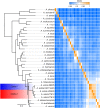Strong Genomic and Phenotypic Heterogeneity in the Aeromonas sobria Species Complex
- PMID: 29276504
- PMCID: PMC5727048
- DOI: 10.3389/fmicb.2017.02434
Strong Genomic and Phenotypic Heterogeneity in the Aeromonas sobria Species Complex
Abstract
Aeromonas sobria is a mesophilic motile aeromonad currently depicted as an opportunistic pathogen, despite increasing evidence of mutualistic interactions in salmonid fish. However, the determinants of its host-microbe associations, either mutualistic or pathogenic, remain less understood than for other aeromonad species. On one side, there is an over-representation of pathogenic interactions in the A. sobria literature, of which only three articles to date report mutualistic interactions; on the other side, genomic characterization of this species is still fairly incomplete as only two draft genomes were published prior to the present work. Consequently, no study specifically investigated the biodiversity of A. sobria. In fact, the investigation of A. sobria as a species complex may have been clouded by: (i) confusion with A. veronii biovar sobria because of their similar biochemical profiles, and (ii) the intrinsic low resolution of previous studies based on 16S rRNA gene sequences and multilocus sequence typing. So far, the only high-resolution, phylogenomic studies of the genus Aeromonas included one A. sobria strain (CECT 4245 / Popoff 208), making it impossible to robustly conclude on the phylogenetic intra-species diversity and the positioning among other Aeromonas species. To further understand the biodiversity and the spectrum of host-microbe interactions in A. sobria as well as its potential genomic diversity, we assessed the genomic and phenotypic heterogeneity among five A. sobria strains: two clinical isolates recovered from infected fish (JF2635 and CECT 4245), one from an infected amphibian (08005) and two recently isolated brook charr probionts (TM12 and TM18) which inhibit in vitro growth of A. salmonicida subsp. salmonicida (a salmonid fish pathogen). A phylogenomic assessment including 2,154 softcore genes corresponding to 946,687 variable sites from 33 Aeromonas genomes confirms the status of A. sobria as a distinct species divided in two subclades, with 100% bootstrap support. The phylogenomic split of A. sobria in two subclades is corroborated by a deep dichotomy between all five A. sobria strains in terms of inhibitory effect against A. salmonicida subsp. salmonicida, gene contents and codon usage. Finally, the antagonistic effect of A. sobria strains TM12 and TM18 suggests novel control methods against A. salmonicida subsp. salmonicida.
Keywords: Aeromonas sobria; bacterial genomics; host–microbe interactions; microbial diversity; molecular systematics.
Figures





Similar articles
-
Stimulated Growth and Innate Immunity in Brook Charr (Salvelinus fontinalis) Treated with a General Probiotic (Bactocell®) and Two Endogenous Probiotics That Inhibit Aeromonas salmonicida In Vitro.Microorganisms. 2019 Jul 6;7(7):193. doi: 10.3390/microorganisms7070193. Microorganisms. 2019. PMID: 31284626 Free PMC article.
-
Taxonomic study of sucrose-positive Aeromonas jandaei-like isolates from faeces, water and eels: emendation of A. jandaei Carnahan et al. 1992.Int J Syst Evol Microbiol. 2003 Sep;53(Pt 5):1411-1419. doi: 10.1099/ijs.0.02504-0. Int J Syst Evol Microbiol. 2003. PMID: 13130026
-
Polyinfection in Fish Aeromoniasis: A Study of Co-Isolated Aeromonas Species in Aeromonas veronii Outbreaks.Pathogens. 2023 Nov 10;12(11):1337. doi: 10.3390/pathogens12111337. Pathogens. 2023. PMID: 38003801 Free PMC article.
-
Occurrence and significance of atypical Aeromonas salmonicida in non-salmonid and salmonid fish species: a review.Dis Aquat Organ. 1998 Feb 26;32(1):49-69. doi: 10.3354/dao032049. Dis Aquat Organ. 1998. PMID: 9696626 Review.
-
[Severe pneumonia caused by Aeromonas veronii biovar sobria: a case report and review of the literature].Zhonghua Jie He He Hu Xi Za Zhi. 2008 Oct;31(10):736-9. Zhonghua Jie He He Hu Xi Za Zhi. 2008. PMID: 19080598 Review. Chinese.
Cited by
-
Characterization of virulence and antimicrobial resistance genes of Aeromonas media strain SD/21-15 from marine sediments in comparison with other Aeromonas spp.Front Microbiol. 2022 Dec 1;13:1022639. doi: 10.3389/fmicb.2022.1022639. eCollection 2022. Front Microbiol. 2022. PMID: 36532448 Free PMC article.
-
Remedial Treatment of Corroded Iron Objects by Environmental Aeromonas Isolates.Appl Environ Microbiol. 2019 Jan 23;85(3):e02042-18. doi: 10.1128/AEM.02042-18. Print 2019 Feb 1. Appl Environ Microbiol. 2019. PMID: 30478230 Free PMC article.
-
Plasmid-Mediated Fluoroquinolone Resistance Genes in Quinolone-Susceptible Aeromonas spp. Phenotypes Isolated From Recreational Surface Freshwater Reservoir.Front Cell Infect Microbiol. 2022 May 11;12:885360. doi: 10.3389/fcimb.2022.885360. eCollection 2022. Front Cell Infect Microbiol. 2022. PMID: 35646727 Free PMC article.
-
Stimulated Growth and Innate Immunity in Brook Charr (Salvelinus fontinalis) Treated with a General Probiotic (Bactocell®) and Two Endogenous Probiotics That Inhibit Aeromonas salmonicida In Vitro.Microorganisms. 2019 Jul 6;7(7):193. doi: 10.3390/microorganisms7070193. Microorganisms. 2019. PMID: 31284626 Free PMC article.
-
GET_PHYLOMARKERS, a Software Package to Select Optimal Orthologous Clusters for Phylogenomics and Inferring Pan-Genome Phylogenies, Used for a Critical Geno-Taxonomic Revision of the Genus Stenotrophomonas.Front Microbiol. 2018 May 1;9:771. doi: 10.3389/fmicb.2018.00771. eCollection 2018. Front Microbiol. 2018. PMID: 29765358 Free PMC article.
References
LinkOut - more resources
Full Text Sources
Other Literature Sources
Molecular Biology Databases

